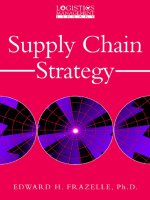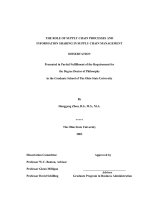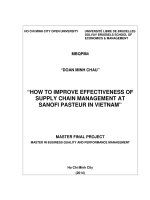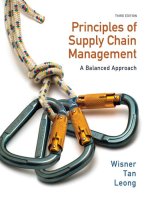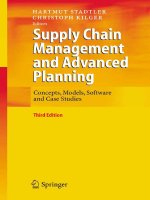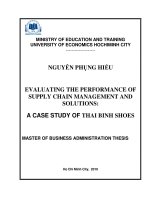Basics of Supply Chain Management and SCOR
Bạn đang xem bản rút gọn của tài liệu. Xem và tải ngay bản đầy đủ của tài liệu tại đây (854.64 KB, 20 trang )
07/06/2011
1
Albert Tan
Associate Director (Industry Research)
The Logistics Institute – Asia Pacific
Basics of Supply Chain Management and
SCOR
Winner for
Best Educational
Course Provider
2003-2010
A Collaboration Between
The Logistics Institute – Asia Pacific
Established in Nov 1998
An initiative of
A collaboration between
Economic Development Board of Singapore
National University of Singapore
Georgia Institute of Technology
Mission: To be the premier institute in Asia Pacific nurturing logistics
excellence in research and education
07/06/2011
2
Agenda
1.Introduction to Supply Chain
Management
2.Manufacturing Planning and Control
from APICS
3.Overview of SCOR model
4.SCOR model for SMEs in Singapore
5.A Case Study using SCOR model
1 4
Supply Chain Management Definitions
• Supply chain: The global network used to deliver
products and services from raw materials to end
customers through an engineered flow of information,
physical distribution, and cash.
• Supply chain management: The design, planning,
execution, control, and monitoring of supply chain
activities with the objective of creating net value, building
a competitive infrastructure, leveraging world-wide
logistics, synchronizing supply with demand, and
measuring performance globally.
─APICS Dictionary
07/06/2011
3
1 5
Basic Supply Chain: External
ManufacturerSuppliers Distributors Retailers
Consumers
Dominant flow of goods and services
Dominant flow of demand and design information
Dominant flow of cash
External supply chain from a manufacturer’s perspective
Returns and reverse logistics
1 6
Traditional Internal Supply Chain View
Raw Materials
Customers
Purchasing Production Distribution
Lowest purchase
price
Inventory buffers
High utilization %
Long runs – minimize
changeovers
Low unit costs
Safety stocks
Full truckload
quantities
Best shipping rate
Safety stocks
07/06/2011
4
1 7
Cross-Functional Supply Chain View
Develop
Products
and
Services
Manage
Procurement
Produce
Products
Supply chain processes
The value chain consists of the value-adding processes that enable a
company to take its products from conception to market
The internal supply chain is a subset of the value chain
Support processes are important but are not considered value chain
processes
Manage Customer Orders and Reverse Logistics
Manage
Distribution
Perform
Marketing
and Sales
Manage Finance
Manage Human Resources
Key support processes:
1 8
Conflicts in Traditional Supply Systems
FinanceMarketing Operations
Inventory investment
Traditional
Objective
Customer service
Production efficiency
Increase profit and
cash flow, reduce
investment
Increase revenue/
satisfy customers
Reduce
manufacturing cost
82 5
93 6
71 4
07/06/2011
5
1 9
Role of Materials Management
Demand
Resources
1 10
Objectives of Manufacturing
• The right products
• Of the right quality
• In the right quantities
• At the right time
• At minimum cost (right price)
07/06/2011
6
1 11
Why Plan?
• To satisfy customer demand and ensure
the availability of resources
– Material
– Capacity
Demand
Resources
1 12
1 12
These are questions of priority and capacity.
A Good Planning and Control System
What must
we get
and
when?
07/06/2011
7
1 13
Manufacturing Planning and Control
Order
Sequencing
Input/Output
Control
Master Scheduling
Capacity
Requirements
Planning (CRP)
Sales & Operations
Planning
Business Planning
Master Planning
Resource
Planning (RP)
Rough-Cut
Capacity Planning
(RCCP)
Priority Planning
Execution
Capacity Planning
Execution
Material
Requirements
Planning (MRP)
Production Activity
Control (PAC)
© APICS CONFIDENTIAL AND PROPRIETARY
1 14
Evolution from MRP to ERP
MRP
MRP
Closed
Loop
MRP II ERP
MRP Processor
Closed-Loop Feedback
Best Practice Processes
Common Database
Sales and Operations
Planning
Total Cross-Functional
Software Process Integration
© APICS CONFIDENTIAL AND PROPRIETARY
07/06/2011
8
15
Supply Chain Council
&
Supply Chain Operations Reference
(SCOR) Model Overview
16
• The SCC is an independent, not-for-profit, global corporation with
membership open to all companies and organizations interested in
applying and advancing state-of-the-art supply chain management
systems and practices.
• Over 700 Company Members
• Cross-industry representation
• Chapters in Australia/New Zealand, Europe, Japan, Korea,
Latin America, and South East Asia with petitions for additional
chapters pending.
• Over 30 new members per month
• The Supply-Chain Council (SCC) has developed and endorsed
the Supply Chain Operations Reference-model (SCOR) as the
cross-industry standard for supply chain management
The SCC was organized in 1996 by Pittiglio Rabin Todd & McGrath (PRTM) and Advanced
Manufacturing Research (AMR), and initially included 69 voluntary member companies
07/06/2011
9
17
Membership
• 700+ SCC members,
• Composition
– Practitioners
– Enabling Technology Providers
– Consultants
– Universities, Associations, Government
Organizations
SCC Member Composition
Practitioners
Software Vendors
Consultants
Universities/Gov.
Orgs/Assns.
SCC Membership by Region
North America
Europe
Japan
Other
18
The Value of SCOR
Index Summary 2003-2005
-10.00%
0.00%
10.00%
20.00%
30.00%
40.00%
50.00%
60.00%
Jan-03 Jan-04 Jan-05
Period
Improvement Percentage
DJIA S&P 500
SCOR
Companies with
formal process
management
• Are 780% more
profitable than
peers
1
.
• Exhibit greater
share growth
than leading
market
indicators
2
.
1 Supply-chain Council 2003 – profit and revenue analysis.
2 PCOR Research 2006 – SCOR company share performance – whitepaper in 2007
07/06/2011
10
19
Supplier
Plan
Customer
Customer’s
Customer
Suppliers’
Supplier
Make
DeliverSource Make
DeliverMakeSource
Deliver
Source
Deliver
Internal or External Internal or External
Your Company
Source
SCOR is structured around five distinct
management processes
SCOR Model
Return
Return Return
Return
Return
Return
Return
Return
Building Block Approach
Processes Metrics
Best Practice Technology
07/06/2011
11
21
Customers
Suppliers
P1 Plan Supply Chain
Plan
P2 Plan Source
P3 Plan Make
P4 Plan Deliver
Source Make Deliver
S1 Source Stocked Products
M1 Make-to-Stock
M2 Make-to-Order
M3 Engineer-to-Order
D1 Deliver Stocked Products
D2 Deliver MTO Products
D3 Deliver ETO Products
S2 Source MTO Products
S3 Source ETO Products
Supply-Chain Operations Reference-model (SCOR)
Return
Source
P5 Plan Returns
Return
Deliver
Enable
22
SCOR Hierarchy
Level 1 Level 2 Level 3 Level 4 Level 5
Scope Configuration Activity Workflow Transactions
Differentiates
Business
Differentiates
Capabilities
Names Tasks Sequences Steps Links
Transactions
Defines Scope,
Enterprise
Strategy
Differentiates
Supply-chain
Strategies
Links, Metrics,
Tasks and
Practices
Job Details Details of
Automation
Framework
Language
Framework
Language
Framework
Language
Industry or
Company
Specific
Language
Technology
Specific
Language
S1
Source
Stocked Product
Supply-Chain
Source
S1.2
Receive Product
Standard SCOR definitions Company/Industry definitions
EDI
XML
07/06/2011
12
23
24
Performance
Attribute
Performance
Attribute
Performance
Attribute
Performance Attribute DefinitionPerformance Attribute DefinitionPerformance Attribute Definition Level 1 MetricLevel 1 MetricLevel 1 Metric
Supply Chain
Delivery Reliability
Supply Chain
Delivery Reliability
The performance of the supply chain in
delivering: the correct product, to the correct
place, at the correct time, in the correct condition
and packaging, in the correct quantity, with the
correct documentation, to the correct customer.
The performance of the supply chain in
delivering: the correct product, to the correct
place, at the correct time, in the correct condition
and packaging, in the correct quantity, with the
correct documentation, to the correct customer.
Delivery PerformanceDelivery Performance
Fill RatesFill Rates
Perfect Order FulfillmentPerfect Order Fulfillment
Supply Chain
Responsiveness
Supply Chain
Responsiveness
The velocity at which a at which a supply chain
provides products to the customer.
The velocity at which a at which a supply chain
provides products to the customer.
Order Fulfillment Lead TimesOrder Fulfillment Lead Times
Supply Chain
Flexibility
Supply Chain
Flexibility
The agility of a supply chain in responding to
marketplace changes to gain or maintain
competitive advantage.
The agility of a supply chain in responding to
marketplace changes to gain or maintain
competitive advantage.
Supply Chain Response TimeSupply Chain Response Time
Production FlexibilityProduction Flexibility
Supply Chain CostsSupply Chain Costs The costs associated with operating the supply
chain.
The costs associated with operating the supply
chain.
Cost of Goods SoldCost of Goods Sold
Total Supply Chain Management
Costs
Total Supply Chain Management
Costs
Value-Added ProductivityValue-Added Productivity
Warranty / Returns Processing
Costs
Warranty / Returns Processing
Costs
Supply Chain Asset
Management
Efficiency
Supply Chain Asset
Management
Efficiency
The effectiveness of an organization in managing
assets to support demand satisfaction. This
includes the management of all assets: fixed and
working capital.
The effectiveness of an organization in managing
assets to support demand satisfaction. This
includes the management of all assets: fixed and
working capital.
Cash-to-Cash Cycle TimeCash-to-Cash Cycle Time
Inventory Days of SupplyInventory Days of Supply
Asset TurnsAsset Turns
Linking Supply Chain Performance Attributes and
Level 1 Metrics
07/06/2011
13
Lesson 2/ Wk 3 25
26 SCOR 8.0 Training Webinar
The SCOR Project Roadmap
Phase Name Deliverable
Resolves
Initial BUILD • Organizational Support
Who is the sponsor?
I DISCOVER
• Supply-Chain Definition
• Supply-Chain Priorities
• Project Charter
What will the program
cover?
II ANALYZE
• Scorecard
• Benchmark
• Competitive Requirements
What are the strategic
requirements of your
supply-chain?
III MATERIAL
• Geo Map
• Thread Diagram
• Disconnect Analysis
Initial Analysis – where
are the problems?
IV WORK
• Transactions
• Level 3, Level 4 Processes
• Best Practices Analysis
Final Analysis – where
are the solutions?
V IMPLEMENT
• Opportunity Analysis
• Project Definition
• Deployment Organization
How to deploy?
07/06/2011
14
27
SCOR Projects – A Wide Range of Adoption
• Consumer Foods
– Project Time (Start to Finish) – 3 months
– Investment - $50,000 US
– 1
st
Year Return - $4,300,000 US
• Electronics
– Project Time (Start to Finish) – 6 months
– Investment - $3-5 Million US
– Projected Return on Investment - $ 230 Million US
• Software and Planning
– SAP bases key performance indicators (KPIs) on SCOR Model
• Aerospace and Defense
– SCOR Benchmarking and use of SCOR metrics to specify
performance criteria and provide basis for contracts / purchase
orders
SCOR for SMEs in Singapore
07/06/2011
15
Apply scale to the SCOR model
Example of Scoring
07/06/2011
16
07/06/2011
17
07/06/2011
18
The Solution
07/06/2011
19
E-SCM incentives for SMEs
07/06/2011
20
The Logistics Institute – Asia Pacific
National University of Singapore
21 Heng Mui Keng Terrace, #04-01
Singapore 119613
Tel: (65) 6516 4842 Fax: (65) 6775 3391
E-mail: Website: www.tliap.nus.edu.sg
